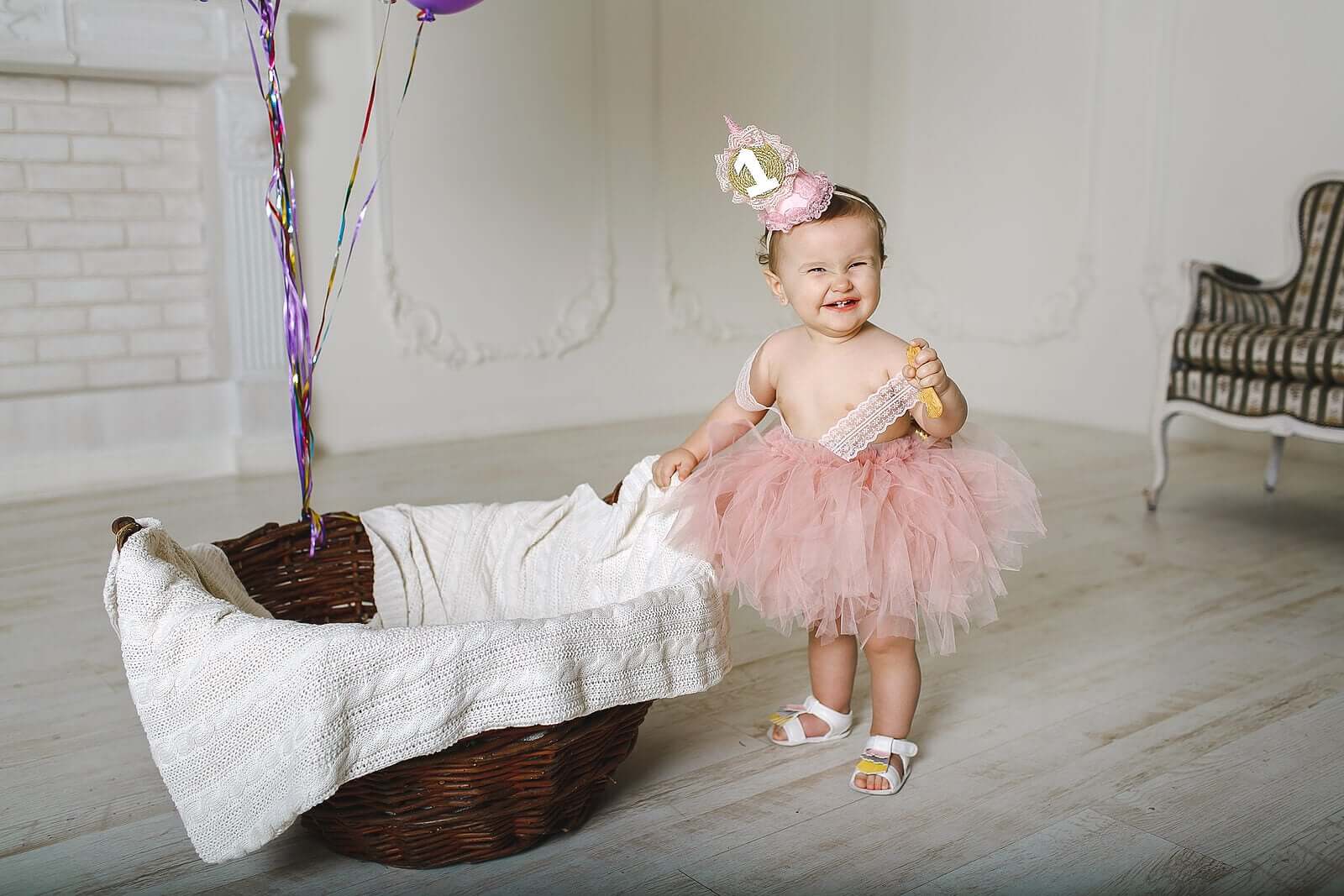The Treasure Basket: a Game to Stimulate Your Baby

As parents, we want to provide our children with the best educational and playful activities. Therefore, we want to buy the most innovative toys, since all of them seem to be necessary for our children. However, sometimes the most simple things are perfect to stimulate our babies. This is what the treasure basket is about.
Nowadays, many teaching techniques base their studies on children’s ability to explore their environment and on the use of natural materials. The treasure basket includes these two important characteristics. So, if you want to learn more about this game and how to make it at home, keep reading.

What is the treasure basket?
The treasure basket is a game suggested by educator Elinor Goldschmied, which promotes learning and stimulation. Numerous schools with alternative approaches to education, like Montessori schools, have adapted and incorporated this game.
This game is ideal for babies from 6 to 12 months old. This age is perfect because of two main reasons: babies can sit on their own, but they don’t walk yet.
Therefore, they focus all their attention on the things they have around them. And, their main concern is to explore and experience playing with the objects they have close at hand.
How can you make the treasure basket at home?
To make a treasure basket you need a basket or a box made with natural materials, such as wicker. Then, you have to put different objects in it. You can use outside objects, such as stones, leaves, chestnuts, etc. And, you can also use household objects, such as corks, tongs, spoons, candles and scrunchies.
Depending on the size of the basket, you’ll pick the size of the objects. Bear in mind that the goal is to stimulate your babies’ senses.
So, you must choose objects from different sizes, shapes, colors and textures. You should also make sure you’ve chosen safe objects and a firm basket, so your baby can play comfortably with it.
Once you have your basket ready, you just have to place it next to your babies, for them to explore and play at their own pace. You should let them choose and play with the objects they prefer. It should be safe for them to put these objects in their mouths. Adults aren’t supposed to intervene. Thus, you should just be with them and make sure they’re safe.
What are the benefits of this game?
Even though this is a very simple game, it can be quite interesting and fun for babies. Besides, it promotes their development. Next, you’ll see why:
- Promotes their independence, by letting them explore and find things on their own.
- Due to the different sizes and colors of the objects, this game stimulates the babies’ five senses.
- Perfect game to work on babies’ psychomotricity and coordination.
- Helps organize their thoughts and their ability to choose from among different options.

- By using these everyday objects, babies become familiar with their environment.
- It’s a game that will always stimulate them, because you can renew the objects from the basket any time you want.
In conclusion, it’s an interesting educational alternative, which promotes children’s development. Even though, at school, teachers use one basket for all the children to play with, at home you can come up with your own design of the game. All in all, it’s a simple, inexpensive and natural game with great benefits.
Usually, we tend to control kids’ natural impulses, like licking and hitting objects. In this case, restrictions disappear and babies are free to explore their environment. Try this game. You won’t regret it!
As parents, we want to provide our children with the best educational and playful activities. Therefore, we want to buy the most innovative toys, since all of them seem to be necessary for our children. However, sometimes the most simple things are perfect to stimulate our babies. This is what the treasure basket is about.
Nowadays, many teaching techniques base their studies on children’s ability to explore their environment and on the use of natural materials. The treasure basket includes these two important characteristics. So, if you want to learn more about this game and how to make it at home, keep reading.

What is the treasure basket?
The treasure basket is a game suggested by educator Elinor Goldschmied, which promotes learning and stimulation. Numerous schools with alternative approaches to education, like Montessori schools, have adapted and incorporated this game.
This game is ideal for babies from 6 to 12 months old. This age is perfect because of two main reasons: babies can sit on their own, but they don’t walk yet.
Therefore, they focus all their attention on the things they have around them. And, their main concern is to explore and experience playing with the objects they have close at hand.
How can you make the treasure basket at home?
To make a treasure basket you need a basket or a box made with natural materials, such as wicker. Then, you have to put different objects in it. You can use outside objects, such as stones, leaves, chestnuts, etc. And, you can also use household objects, such as corks, tongs, spoons, candles and scrunchies.
Depending on the size of the basket, you’ll pick the size of the objects. Bear in mind that the goal is to stimulate your babies’ senses.
So, you must choose objects from different sizes, shapes, colors and textures. You should also make sure you’ve chosen safe objects and a firm basket, so your baby can play comfortably with it.
Once you have your basket ready, you just have to place it next to your babies, for them to explore and play at their own pace. You should let them choose and play with the objects they prefer. It should be safe for them to put these objects in their mouths. Adults aren’t supposed to intervene. Thus, you should just be with them and make sure they’re safe.
What are the benefits of this game?
Even though this is a very simple game, it can be quite interesting and fun for babies. Besides, it promotes their development. Next, you’ll see why:
- Promotes their independence, by letting them explore and find things on their own.
- Due to the different sizes and colors of the objects, this game stimulates the babies’ five senses.
- Perfect game to work on babies’ psychomotricity and coordination.
- Helps organize their thoughts and their ability to choose from among different options.

- By using these everyday objects, babies become familiar with their environment.
- It’s a game that will always stimulate them, because you can renew the objects from the basket any time you want.
In conclusion, it’s an interesting educational alternative, which promotes children’s development. Even though, at school, teachers use one basket for all the children to play with, at home you can come up with your own design of the game. All in all, it’s a simple, inexpensive and natural game with great benefits.
Usually, we tend to control kids’ natural impulses, like licking and hitting objects. In this case, restrictions disappear and babies are free to explore their environment. Try this game. You won’t regret it!
All cited sources were thoroughly reviewed by our team to ensure their quality, reliability, currency, and validity. The bibliography of this article was considered reliable and of academic or scientific accuracy.
- Goldschmied, E., & Jackson, S. (2004). People under three: Young children in day care. Psychology Press. https://books.google.es/books?hl=es&lr=&id=AS2jHaPVdxkC&oi=fnd&pg=PR9&dq=elinor+goldschmied+treasure+baskets&ots=p4exhdGM02&sig=KER6Rnwveu59IstFRyB-2G0HHNk#v=onepage&q=elinor%20goldschmied%20treasure%20baskets&f=false
- Auld, S. (2002). Five key principles of heuristic play. The First Years: Nga Tau Tuatahi, New Zealand Journal of Infant and Toddler Education, 4(2), 36-37. https://dufferincounty.ca/sites/default/files/rtb/FivePrinciplesHeuristicPlay.pdf
This text is provided for informational purposes only and does not replace consultation with a professional. If in doubt, consult your specialist.








